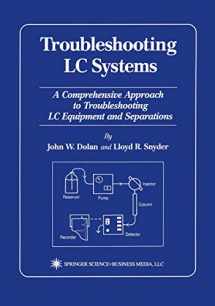
Troubleshooting LC Systems: A Comprehensive Approach to Troubleshooting LC Equipment and Separations
ISBN-13:
9781475768794
ISBN-10:
1475768796
Edition:
Softcover reprint of the original 1st ed. 1989
Author:
Lloyd R. Snyder, John W. Dolan
Publication date:
2013
Publisher:
Humana
Format:
Paperback
523 pages
Category:
Computer Science
,
Hardware & DIY
,
Analytic
,
Chemistry
FREE US shipping
Book details
ISBN-13:
9781475768794
ISBN-10:
1475768796
Edition:
Softcover reprint of the original 1st ed. 1989
Author:
Lloyd R. Snyder, John W. Dolan
Publication date:
2013
Publisher:
Humana
Format:
Paperback
523 pages
Category:
Computer Science
,
Hardware & DIY
,
Analytic
,
Chemistry
Summary
Troubleshooting LC Systems: A Comprehensive Approach to Troubleshooting LC Equipment and Separations (ISBN-13: 9781475768794 and ISBN-10: 1475768796), written by authors
Lloyd R. Snyder, John W. Dolan, was published by Humana in 2013.
With an overall rating of 3.6 stars, it's a notable title among other
Computer Science
(Hardware & DIY, Analytic, Chemistry) books. You can easily purchase or rent Troubleshooting LC Systems: A Comprehensive Approach to Troubleshooting LC Equipment and Separations (Paperback) from BooksRun,
along with many other new and used
Computer Science
books
and textbooks.
And, if you're looking to sell your copy, our current buyback offer is $0.3.
Description
Over the last 15 years, high-performance liquid chromatogra phy (LC) has made the transition from an instrument used only by experts in research labs to a tool used for routine applications by relatively unskilled workers. With this transition have come in instrumentation and column technology. In major advances the past, the operator had to be a jack-of-all-trades, with a screw driver, soldering iron, and various wrenches as constant compan ions in the LC lab. Today, many instruments contain micropro cessors as powerful as those of mainframe computers of earlier days. With this technology has come a variety of self-diagnostic tools that allow the LC system to locate many of its own prob lems. Traditionally, well-honed LC troubleshooting skills have been a result of years of work at the bench. Today the LC system itself often can do a better job of troubleshooting than the operator can. Yet many of the problems of the past are still the major problems of today: air bubbles, check valves, detector lamps, and, of course, problems with the separation. An added pressure on the operator of today's LC system is that of productivity-the lab often cannot afford unnecessary downtime. This means that the operator has to be a troubleshooting expert, or has to have that expertise at his or her fingertips. The present book was written to provide this expertise in an easy-to-use format for users at all levels of experience.


We would LOVE it if you could help us and other readers by reviewing the book
Book review

Congratulations! We have received your book review.
{user}
{createdAt}
by {truncated_author}


